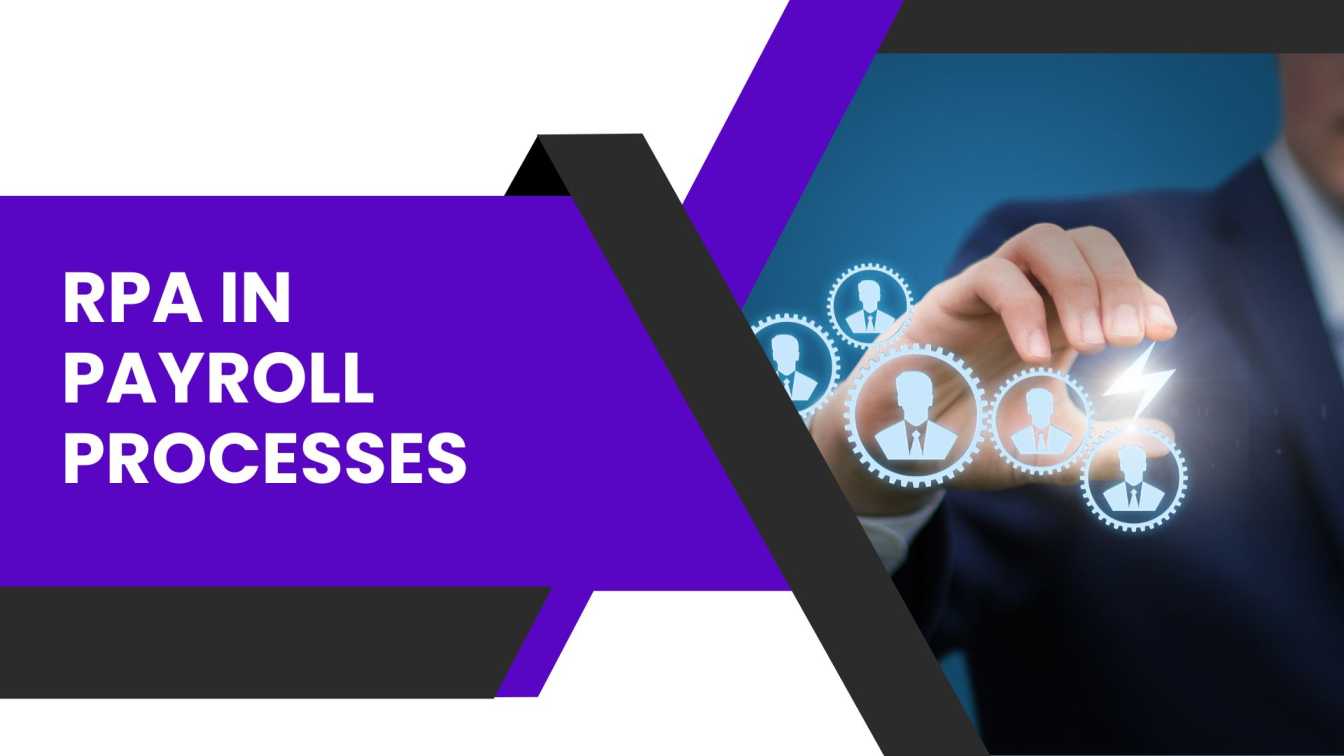Businesses in the fast-paced world are using automation to enhance efficiency and minimize expenses in their operations. Among all business operations, payroll processing ranks as one of the longest and error-prone procedures. A payroll commonly contains numerous repetitive rule-based tasks that need both exact accuracy along with correct compliance with legal mandates. Worker dissatisfaction from payroll mistakes, together with legal troubles and financial damage,s are likely to occur.
Organizations use RPA Robotic Process Automation technology as a disruptive tool to automate daily operations for achieving increased accuracy and speed together with regulatory compliance. Payroll automation helps businesses stay law-abiding while processing payroll and decreases personnel activities, and speeds up payroll computation. RPA technology will significantly transform how organizations handle payroll matters. This guide covers RPA benefits and practical applications as well as implementation methods, typical challenges, and the future of intelligent automation in payroll management systems.
What is RPA in payroll?
RPA performs the reproduction of human work for executing programmed rules-based processes. RPA bots efficiently retrieve data while handling it across multiple applications and platforms to perform data delivery operations. The payroll processing system allows RPA technology to operate independently without needing human involvement to complete data entry tasks and perform payroll computations and deductions, and administer employee benefits while generating reports and distributing payslips.
How does RPA work in Payroll?
- Payroll automation run by RPA could assist in:
- Extract and confirm staff information from various sources.
- Automate complex data such as overtime, tax deductions, and incentives.
- Make sure labor laws and tax rules are followed.
- Generate and securely deliver payslips.
- Flag errors for human review and spot odd patterns.
- Encourage tax compliance and enable reporting to the legislative body.
By using AI, machine learning (ML), and natural language processing (NLP) for more advanced decision-making and data analysis, companies can further increase payroll efficiency using hyperautomation services that integrate RPA.
Main advantages of payroll RPA
1. Higher compliance and accuracy
Financial fines, staff disputes, and labor law non-compliance are some of the serious repercussions of payroll errors. By guaranteeing flawless, consistent execution of tax deductions and payroll calculations, robotic process automation eliminates human errors.
- RPA bots flag irregularities by cross-checking information with previously established rules.
- Non-compliance and fines are reduced by computerized tax calculations.
- Helps employees follow FLSA, GDPR, and any other payroll rules.
2. Operational efficiency and Reduced costs
Payroll processing uses many resources on repeat and trying chores. Companies can greatly cut down on operational costs by using custom software for payroll automation.
- RPA solutions remove the need for manual payroll data entry and reduce labour costs.
- Using automation lowers payroll processing time.
- Rather than doing dull administrative chores, human resources and payroll staff can concentrate on other important projects.
3. Quicker Payroll Processing
Particularly for big businesses, manual payroll systems might take days to finish. RPA automation allows payroll cycles to be finished in a few hours, guaranteeing that employees get their salary on time.
By guaranteeing timely compensation, automated payroll processing enhances employee morale.
Reduces payroll cycle time, hence making last-minute changes possible.
4. Improved Data Security
Since payroll information is very sensitive, manual handling raises the possibility of security breaches. Intelligent automation systems help to reduce the chances of unauthorized access.
- RPA bots lower data exposure by working under established security standards.
- Limiting manual access to payroll records eliminates the possibility of internal fraud.
Helps to meet data protection laws like GDPR and CCPA.
5. Better adaptability and scalability
Traditional payroll systems have difficulty meeting increasing staff requirements. RPA robotic process automation lets payroll departments expand easily.
- Quickly fits seasonal workforce fluctuations
- Manages several sites and currency payrolls without extra help.
- Integrating smoothly with existing HRMS as well as ERP programmes.
Key use cases of RPA in Payroll
RPA has many use cases in different industries. Some of the use cases in payroll are:
1. Employee Management and data entry
Updating and inputting employee records is among the most time-consuming payroll assignments. RPA bots can pull data from employee onboarding forms, verify data, and, without errors, update HR systems.
- Automate processing new staff, promotions, and terminations.
- Synchronizes employee files among several HR databases and payrolls.
2. Payroll calculations and salary processing
Automating difficult payroll calculations, RPA robots guarantee that employees get correct salaries on time.
- Compute bonuses, extra time, credits, and perks.
- Applies for various employee level contracts, full-time, freelance, and custom policies.
- Validates salaries against recorded payroll data to find any differences.
3. Payroll Compliance and Tax Payment
One of the most difficult payroll issues is compliance with legal laws and regulatory demands. RPA guarantees payroll computations in line with local, national, and worldwide tax laws.
- Automates insurance, social security, and income tax payments.
- Gets tax papers ready and delivers them to official bodies.
- Produced for audit purpose compliance documents.
4. Creating Paychecks and Distribution
Errors and inefficiency abound in manual payslip handling. RPA systems automatically create payslips and deliver them safely to workers.
- Make personalized digital payslips in email or PDF version.
- Sends payslips via email, HR portals, or worker self-service apps.
5. Resolving issues and answering payroll questions
Payroll departments receive employee questions often concerning salary, deductions, and tax computations. RPA bots driven by artificial intelligence could take on typical payroll questions and reduce difficulties for HR.
- Offers immediate answers for payroll inquiries.
- Raises sophisticated payroll problems for human analysts.
- Automatically answering repetitious questions, which in turn lowers HR workload.
6. RPA in Payroll Audits and Fraud Detection
Businesses face major legal and financial repercussions from compliance breaches and payroll fraud. RPA robotic process automation allows businesses to audit payroll transactions, find fraudulent activities, and comply with financial laws.
- RPA bots cross-reference payroll data with preset criteria to locate errors.
- Every payroll transaction is recorded, thus forming an open and verifiable audit trail.
- Bots check regulatory compliance, they ensure that payroll follows benefits policies, tax laws, and minimum wage laws.
Combining RPA technologies with AI-powered fraud detection helps companies to lower payroll
fraud risks and yet meet all of the labor laws and tax regulations.
7. RPA is used for Multi-Country Payroll Management
Because of different tax laws, compliance standards, and currency variations, international businesses with staff members spread across many nations find payroll management quite difficult. By guaranteeing accuracy, compliance, and efficiency in various regions, RPA automation simplifies multi-country payroll handling.
- RPA bots estimate salaries in several currencies and apply current exchange rates.
- Country-specific compliance makes sure local tax laws, social security contributions, and labor directives are followed.
- Seamless Data Integration with local payroll companies, HRMS applications, and financial institutions.
- Standardized Payroll Reporting maintains a central payroll system even while creating thorough payroll reports for every country.
Intelligent automation and hyperautomation solutions help businesses to simplify manual payroll issues, minimize compliance risk, and guarantee smooth salary processing for their international staff using intelligent automation and hyperautomation services.
How to implement RPA in payroll?
Step 1: Evaluate Payroll Procedures
Pick low-value, repetitive, and error-prone payroll activities that can be automated.
Step 2: Select the appropriate RPA solution
Choose an RPA development company that fits your payroll processing requirements.
Step 3: Create Custom-Designed Software
Use custom intelligent automation software to improve payroll performance.
Step 4: Complete a pilot test
Before the entire rollout, conduct a small test to discover possible issues.
Step 5: Full-scale application
Control performance and roll out RPA automation across the full payroll system.
Step 6: Continuous Improvement
After implementing, make sure continuous improvements are made according to new regulations and business needs.
Challenges of implementing RPA in Payroll and Their solutions
1. Standardization of processes
Solution: Standardize payroll processes before RPA is rolled out.
2. Change Management
Solution: Train staff members how RPA helps payroll departments.
3. Integration with Current Systems
Solution: Select RPA solutions that work with HRMS, ERP, and accounting systems.
4. Regulatory Updates and Compliance
Solution: Keep RPA bots regularly updated to match changes in tax rules and labor laws.
Where is Payroll Automation Heading with RPA and Hyperautomation?
Hyperautomation services are a blend of RPA, artificial intelligence, machine learning, and sophisticated analytics pointing towards the future of payroll automation.
Trends in payroll automation
- Using artificial intelligence-generated payroll analysis should give predictive information on wage patterns.
- Voice-activated payroll assistants help employees with instant salary information via artificial intelligence assistants.
- With the help of blockchain-powered payroll using blockchain technology, companies will be able to process their payroll securely and openly.
Conclusion
By enhancing efficiency, precision, and compliance, RPA in payroll is transforming age-old payroll management techniques. Companies using RPA technology and hyperautomation services attain a competitive edge by improving data security as well as speeding up processing times and lowering payroll errors. Companies using smart automation can future-proof their payroll systems while enabling HR and financial departments to concentrate on tactical projects. Payroll departments need to be ahead of new automation trends to optimize efficiency and compliance as robotic process automation improves. Choose RPA for payroll automation and future-proof your company.
FAQs
Question 1. Does the implementation of RPA create better payroll compliance?
Answer: RPA maintains payroll compliance because it automates the process of tax regulation updates, employee data verification, and report generation to prevent penalties.
Question 2. Can RPA handle cross-country payments?
Answer: The RPA system controls currency exchange processes while ensuring payroll meets tax law requirements throughout different countries, which provides errorless global payroll management.
Question 3. Is the RPA payroll secure?
Answer: Absolutely! The robotic process automation system implements rigorous security standards that preserve payroll information confidentiality and block unauthorized access to data.

